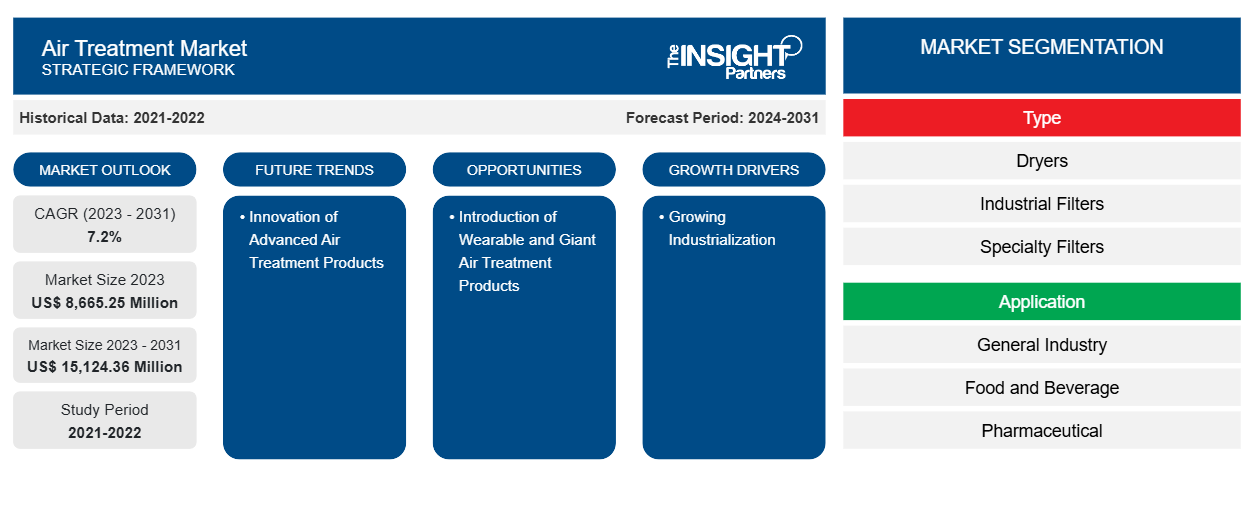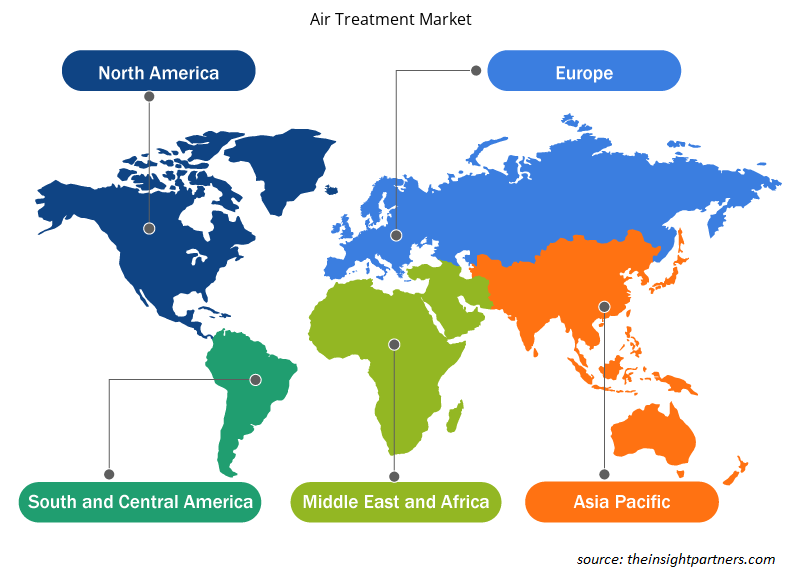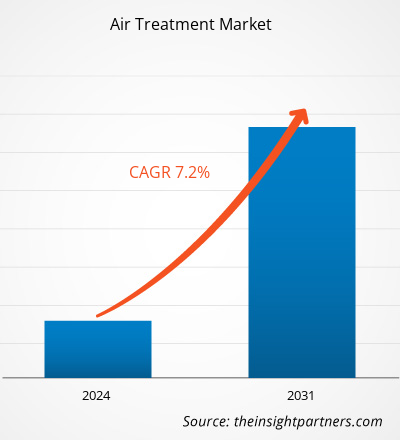The air treatment market size is projected to reach US$ 15,124.36 million by 2031 from US$ 8,665.25 million in 2023. The market is expected to register a CAGR of 7.2% during 2023–2031. The innovation of advanced air treatment products is likely to remain a key trend in the market.
Air Treatment Market Analysis
The major end-users of the air treatment market include power, food and beverages, and petrochemical sectors. Urban growth is projected to take place in slums and other informally built parts of the states and countries in the coming years. Furthermore, favorable growth conditions globally and growing infrastructural projects have propelled the growth rate of the air treatment market globally.
Air Treatment Market Overview
The key stakeholders in the global air treatment market ecosystem include hardware/component providers, air treatment manufacturers/providers, and end-users. Component/hardware providers provide various components/parts/raw materials to air treatment manufacturers for the manufacturing of the end product. Different types of raw materials are used to make air treatment products. Some of the key market manufacturers in the global air treatment market include ABIONIK Group GmbH, Beko Technologies, Donaldson Company, Inc., Condorchem Envitech, Parker Hannifin, Kaesar Kompressoren, Mikropor, Odatech Pty Ltd., SPX FLOW, Inc., and Xebec Adsorption Inc among many others.
Customize This Report To Suit Your Requirement
You will get customization on any report - free of charge - including parts of this report, or country-level analysis, Excel Data pack, as well as avail great offers and discounts for start-ups & universities
Air Treatment Market: Strategic Insights

- Get Top Key Market Trends of this report.This FREE sample will include data analysis, ranging from market trends to estimates and forecasts.
You will get customization on any report - free of charge - including parts of this report, or country-level analysis, Excel Data pack, as well as avail great offers and discounts for start-ups & universities
Air Treatment Market: Strategic Insights

- Get Top Key Market Trends of this report.This FREE sample will include data analysis, ranging from market trends to estimates and forecasts.
Air Treatment Market Drivers and Opportunities
Growing Industrialization to Favor Market
The air treatment industry is driven directly or indirectly by vigorous government measures to support the industrial sector, such as those undertaken by major regions such as North America and Europe, through various forums. Policies in Europe are beneficial for the development of the business, which is one of the reasons behind the growth of the electronic industry and SMEs in Europe. The formation of the EU region has led to ease of business, import, and export among the members of the union. These industries are very common in this region. Thus, the growing development of the industrial sector is steering the demand for the air treatment market globally.
Introduction of Wearable and Giant Air Treatment Products
Air filtration systems are installed to ensure safety in industrial workplaces. The rising trend of air treatment systems helps in capturing the smallest fume particles in industrial areas. Advanced metal fabrication leveraged advanced technology and automation processes to produce products that release heating processes, harmful gases, and fumes as a by-product of welding. This has fueled the installation of dust collector systems with high-quality filtration cartridges. The growing advent of wearable and giant air treatment products in the industrial sector is one of the major growth opportunity providers for the market in the coming years.
Air Treatment Market Report Segmentation Analysis
Key segments that contributed to the derivation of the air treatment market analysis are type and application.
- Based on the type, the air treatment market is divided into dryers, industrial filters, specialty filters, and condensate management. The industrial filters segment held a larger market share in 2023.
- By application, the market is segmented into general industry, food and beverage, pharmaceutical, oil and gas, chemical and petrochemical, and mining. The pharmaceutical segment held a significant share of the market in 2023.
Air Treatment Market Share Analysis by Geography
The geographic scope of the Air Treatment market report is mainly divided into five regions: North America, Asia Pacific, Europe, Middle East & Africa, and South & Central America.
North America is leading the market. The population of the US has an elevated standard of living, and the spending capacity of people is also immense owing to the high per capita income of the country. This results in the use of more facilities and increases the consumption of resources in the region. This will further result in a rising need for fresh air in the country, thus influencing the growth of the air treatment market. North America is a technologically advanced region. Smart air purifiers have witnessed high adoption in this region. These technologies, when integrated with machines, provide efficiencies to the end-users. More deployments call for more competition in the region along with the growth of the entire industry leading to market development and innovations.
Air Treatment Market Regional Insights
The regional trends and factors influencing the Air Treatment Market throughout the forecast period have been thoroughly explained by the analysts at Insight Partners. This section also discusses Air Treatment Market segments and geography across North America, Europe, Asia Pacific, Middle East and Africa, and South and Central America.

- Get the Regional Specific Data for Air Treatment Market
Air Treatment Market Report Scope
| Report Attribute | Details |
|---|---|
| Market size in 2023 | US$ 8,665.25 Million |
| Market Size by 2031 | US$ 15,124.36 Million |
| Global CAGR (2023 - 2031) | 7.2% |
| Historical Data | 2021-2022 |
| Forecast period | 2024-2031 |
| Segments Covered |
By Type
|
| Regions and Countries Covered | North America
|
| Market leaders and key company profiles |
Air Treatment Market Players Density: Understanding Its Impact on Business Dynamics
The Air Treatment Market is growing rapidly, driven by increasing end-user demand due to factors such as evolving consumer preferences, technological advancements, and greater awareness of the product's benefits. As demand rises, businesses are expanding their offerings, innovating to meet consumer needs, and capitalizing on emerging trends, which further fuels market growth.
Market players density refers to the distribution of firms or companies operating within a particular market or industry. It indicates how many competitors (market players) are present in a given market space relative to its size or total market value.
Major Companies operating in the Air Treatment Market are:
- Beko Technologies
- Donaldson Company, Inc.
- Parker Hannifin
- Honeywell International Inc
- Hongrijia Depurate Facility Science?Technology Co.,Ltd
- Ingersoll Rand Inc.
Disclaimer: The companies listed above are not ranked in any particular order.

- Get the Air Treatment Market top key players overview
Air Treatment Market News and Recent Developments
The Air Treatment market is evaluated by gathering qualitative and quantitative data post primary and secondary research, which includes important corporate publications, association data, and databases. A few of the developments in the Air Treatment market are listed below:
- Ingersoll Rand Inc., a global provider of mission-critical flow creation and industrial solutions, closed on the acquisition of Friulair S.r.l. (“Friulair”) in an all-cash upfront purchase price of approximately US$ 146 Million. (Source: Ingersoll Rand Inc, Press Release, February 2024)
- Honeywell International Inc. launched its Indoor Air Quality (IAQ) monitor, which alerts building owners and operators of potential issues to proactively improve indoor air quality, thereby potentially decreasing the risk of transmitting airborne contaminants. (Source: Honeywell International Inc., Press Release, February 2022)
Air Treatment Market Report Coverage and Deliverables
The “Air Treatment Market Size and Forecast (2021–2031)” report provides a detailed analysis of the market covering below areas:
- Air treatment market size and forecast at global, regional, and country levels for all the key market segments covered under the scope
- Air treatment market trends as well as market dynamics such as drivers, restraints, and key opportunities
- Detailed PEST and SWOT analysis
- Air treatment market analysis covering key market trends, global and regional framework, major players, regulations, and recent market developments
- Industry landscape and competition analysis covering market concentration, heat map analysis, prominent players, and recent developments for the air treatment market
- Detailed company profiles
Frequently Asked Questions
Which region dominated the air treatment market in 2023?
North America dominated the air treatment market in 2023.
What are the future trends of the air treatment market?
The introduction of wearable and giant air treatment products is the future trend of the air treatment market.
Which are the leading players operating in the air treatment market?
Beko Technologies, Donaldson Company, Inc., Parker Hannifin, Honeywell International Inc, Hongrijia Depurate Facility Science&Technology Co., Ltd, Ingersoll Rand Inc., Kaesar Kompressoren, Mikropor, OMEGA AIR d.o.o. Ljubljana ORION Electronics Ltd. is some of the leading players in the market.
What would be the estimated value of the air treatment market by 2031?
US$ 15124.36 million estimated value of the air treatment market by 2031.
What is the expected CAGR of the air treatment market?
7.2% is the expected CAGR of the air treatment market.
- Historical Analysis (2 Years), Base Year, Forecast (7 Years) with CAGR
- PEST and SWOT Analysis
- Market Size Value / Volume - Global, Regional, Country
- Industry and Competitive Landscape
- Excel Dataset
Testimonials
I wish to appreciate your support and the professionalism you displayed in the course of attending to my request for information regarding to infectious disease IVD market in Nigeria. I appreciate your patience, your guidance, and the fact that you were willing to offer a discount, which eventually made it possible for us to close a deal. I look forward to engaging The Insight Partners in the future, all thanks to the impression you have created in me as a result of this first encounter.
DR CHIJIOKE ONYIA, MANAGING DIRECTOR, PineCrest Healthcare Ltd.The Insight Partners delivered insightful, well-structured market research with strong domain expertise. Their team was professional and responsive throughout. The user-friendly website made accessing industry reports seamless. We highly recommend them for reliable, high-quality research services
Yukihiko Adachi CEO, Deep Blue, LLC.Reason to Buy
- Informed Decision-Making
- Understanding Market Dynamics
- Competitive Analysis
- Customer Insights
- Market Forecasts
- Risk Mitigation
- Strategic Planning
- Investment Justification
- Identifying Emerging Markets
- Enhancing Marketing Strategies
- Boosting Operational Efficiency
- Tracking Industry Innovations
- Aligning with Regulatory Trends
Yes! We provide a free sample of the report, which includes Report Scope (Table of Contents), report structure, and selected insights to help you assess the value of the full report. Please click on the "Download Sample" button or contact us to receive your copy.
Absolutely — analyst assistance is part of the package. You can connect with our analyst post-purchase to clarify report insights, methodology or discuss how the findings apply to your business needs.
Once your order is successfully placed, you will receive a confirmation email along with your invoice.
• For published reports: You’ll receive access to the report within 4–6 working hours via a secured email sent to your email.
• For upcoming reports: Your order will be recorded as a pre-booking. Our team will share the estimated release date and keep you informed of any updates. As soon as the report is published, it will be delivered to your registered email.
We offer customization options to align the report with your specific objectives. Whether you need deeper insights into a particular region, industry segment, competitor analysis, or data cut, our research team can tailor the report accordingly. Please share your requirements with us, and we’ll be happy to provide a customized proposal or scope.
The report is available in either PDF format or as an Excel dataset, depending on the license you choose.
The PDF version provides the full analysis and visuals in a ready-to-read format. The Excel dataset includes all underlying data tables for easy manipulation and further analysis.
Please review the license options at checkout or contact us to confirm which formats are included with your purchase.
Our payment process is fully secure and PCI-DSS compliant.
We use trusted and encrypted payment gateways to ensure that all transactions are protected with industry-standard SSL encryption. Your payment details are never stored on our servers and are handled securely by certified third-party processors.
You can make your purchase with confidence, knowing your personal and financial information is safe with us.
Yes, we do offer special pricing for bulk purchases.
If you're interested in purchasing multiple reports, we’re happy to provide a customized bundle offer or volume-based discount tailored to your needs. Please contact our sales team with the list of reports you’re considering, and we’ll share a personalized quote.
Yes, absolutely.
Our team is available to help you make an informed decision. Whether you have questions about the report’s scope, methodology, customization options, or which license suits you best, we’re here to assist. Please reach out to us at sales@theinsightpartners.com, and one of our representatives will get in touch promptly.
Yes, a billing invoice will be automatically generated and sent to your registered email upon successful completion of your purchase.
If you need the invoice in a specific format or require additional details (such as company name, GST, or VAT information), feel free to contact us, and we’ll be happy to assist.
Yes, certainly.
If you encounter any difficulties accessing or receiving your report, our support team is ready to assist you. Simply reach out to us via email or live chat with your order information, and we’ll ensure the issue is resolved quickly so you can access your report without interruption.





















 Get Free Sample For
Get Free Sample For